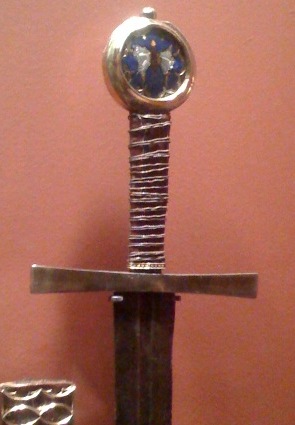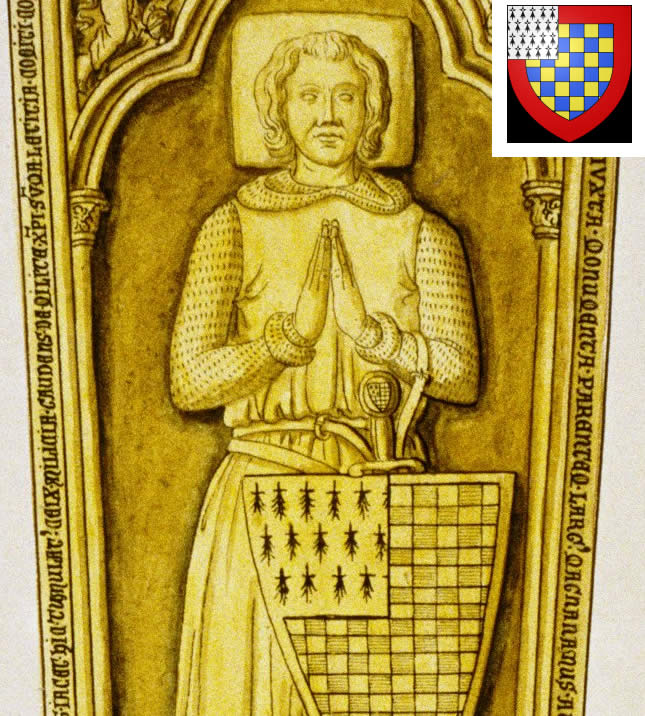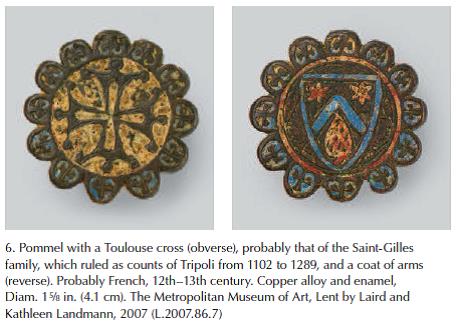Posts: 1,086 Location: Austin TX
Mon 16 May, 2011 12:14 pm
Painted sword pommels
I'd like to gather some pictures of painted ornementation on sword pommels (and guards). What kind of paint was actually used, enamel?
This sword below (it is currently at the musee de cluny in Paris during the exposition dedicated to the sword). I have seen it on the forum before, but I can't recall where. A better shot or even a close shot would be great. Other examples would be awesome.
Thanks in advance.
J
 Attachment: 33.29 KB
Attachment: 33.29 KB

Posts: 11,553 Location: San Francisco
Mon 16 May, 2011 12:32 pm
Posts: 1,086 Location: Austin TX
Tue 17 May, 2011 1:40 am
fantastic pictures. Thx for taking the time to re upload them here Nathan.
I wonder about the details of this pommel. Even if the picture close up exceeds my expectation it can't beat direct examination (damn, I will have to go to the paris expo after all), it is still hard to figure out if:
the enamel is applied directly on the metal, or if there is a layer of glass/crystal underneath (I mean in order to obtain this translucent quality you have to have a transparent medium do you?)
is the arch gothic border actually raised from the bottom of the pommel (it would make sense if there is a "lense" of glass crystal underneath) or simply painted on the bottom of the pommel.
I have looked at cold enamel tutorials and it still seems quiet complicated in the sense that control of the substance seems to be an issue (what I've seen was about simply pouring the enamel in a recessed area).
Can one paint enamel? And in which case do you think model enamel paint would produce a convincing effect? Did anyone tried? (I've seen heraldic devices painted on some deltin pommels already but not something of that scale).
Posts: 845
Tue 17 May, 2011 12:00 pm
Looks like cloisonne to me:
http://en.wikipedia.org/wiki/Cloisonn%C3%A9
It's both an ancient and preferred method for doing exactly what you are describing. There is even some from Sutton Hoo:
http://www.britishmuseum.org/explore/highligh...page=20819
The above example is of course, elaborate - with glass inlays and detailed wire-work. However, the simplest form would be etching out the metal and simply painting the recesses with enamel - such as appears in the photo which Nathan posted or the A&A
Edward III below. :)
[ Linked Image ]
Photo intellectual property of Kult of Athena and Arms & Armor of Minnesota.
Posts: 259 Location: Kristiansand, Norway
Wed 18 May, 2011 12:23 am
| Julien M wrote: |
f
the enamel is applied directly on the metal, or if there is a layer of glass/crystal underneath (I mean in order to obtain this translucent quality you have to have a transparent medium do you?)
. |
Not that I know how it is done on the examples posted here, but vitreous enamel is usually applied directly on the base metal. Since it is powdered glass, it can stay translucent or semi-translucent after it has been applied, although it doesn't have to be. I do not know how you can control the end result though.
Johan Schubert Moen
Posts: 1,086 Location: Austin TX
Wed 18 May, 2011 1:47 am
Hi Guys,
Thanks for your input, that led me to refine my search and I found this great video made by vanessa Richi, professionnal "e
mailleuse" chez Jean Richard (luxury watches), demonstrating cloisonné enamel. It's in french but subbed in english. Spendid and very informative.
http://www.youtube.com/watch?v=LbTgrYWwxp8
edit: one thing is still bugging me. She says that the watchmaker has to use extreme caution when mounting the enamel background on the watch, as it is very fragile. It seems unlikely that it might be used on a sword pommel...
Posts: 259 Location: Kristiansand, Norway
Wed 18 May, 2011 11:36 am
The enamel background for the watch is fairly thin stuff, so you'd have to be careful, if you bend it or hit it the enamel would probably come off. A sword pommel can dissipate quite a bit more force and it doesn't deform easily, so it shouldn't be a problem. That being said, if you hit it with a hammer you'd probably have to redo the work...it's just glass after all.
EDIT: To add one more tidbit; the earlier-mentioned Sutton Hoo sword is not enamelled. It is cloisonne, but with cut garnets set in rather than enamel.
Johan Schubert Moen
Posts: 702 Location: Whitestone, NY
Mon 10 Jun, 2013 11:12 am
I know I'm reviving an old thread here, but does anyone have any other pictures of painted pommels? I'm trying to find some artwork to paint on my Durer.
Posts: 1,303 Location: Jackson, MS, USA
Mon 10 Jun, 2013 11:25 am
The Met's got the pommel of Peter of Dreux, believed to have been lost at al-Mansourah.
http://www.metmuseum.org/collections/search-t...s/40005997
[ Linked Image ]
[ Linked Image ]
Posts: 1,303 Location: Jackson, MS, USA
Fri 12 Jul, 2013 2:04 am
Posts: 83
Fri 12 Jul, 2013 9:37 am
Enamel
All of those look like glass enamel, not paint.
Mark
Posts: 1,303 Location: Jackson, MS, USA
Sun 09 Nov, 2014 7:48 pm
A worthwhile film from the V&A explaining the technique of champlevé enameling.
http://www.vam.ac.uk/content/articles/c/champ...1100-1250/
I don't understand how they could enamel both sides of a pommel at the same time without the enameling running. Are these pommels constructed of multiple plates, or is this a type of "sealing-wax" enameling, where glass panes or rods were only softened before application instead of using powdered glass?
http://en.wikipedia.org/wiki/Champlev%C3%A9
Posts: 13 Location: London
Mon 10 Nov, 2014 5:20 am
Thank you for bringing this pommel to our attention, Mart. The image below is a detail from an early eighteenth century drawing of the tomb of Peter of Dreux (Peter I, Duke of Brittany), which shows his sword with a similar pommel. Courtesy of Wikipedia, I have added the coat of arms in the top right to show the historically correct colours.
image source: http://bodley30.bodley.ox.ac.uk:8180/luna/servlet/s/n9xz8c
 Attachment: 117.81 KB
Attachment: 117.81 KB

Posts: 1,303 Location: Jackson, MS, USA
Mon 10 Nov, 2014 9:31 am
The Dreux Window at Chartres Cathedral
http://upload.wikimedia.org/wikipedia/commons...dral01.jpg
And the window showing Peter dropping his sword after being wounded at the Battle of Mansourah in 1250, commonly known as the "Mauclerc" window. Peter's nickname was given due to his bad intent towards the clergy in Britanny, so it was undoubtedly considered a just reward to show his defeat in a church window. The pommel was discovered in a Damascus market.
[ Linked Image ]
http://www.google.com/url?sa=t&rct=j&...9006,d.aWw
| STEPHEN V. GRANCSAY wrote: |
A FRENCH CRUSADER'S
SWORD POMMEL
-------------
Our pommel is enriched with champleve
enamel, the grooves for the vitreous colors
being channeled in the copper base. On the
obverse appears the shield of arms of Peter
of Dreux, Duke of Brittany, alternate
squares of blue and gold (designating the
house of Dreux) quartered with ermines
(Brittany). On the reverse, in a shield with
a green field, is a cross set with red enamel,
and in the background are carved scrolls or
vines, probably typifying Christ. Colored
enamels were, of course, ideal for showing
heraldic arms. In the present instance, however,
the enamels no longer retain their
brilliant hues or their original high luster.
Here and there are small flecks of gold
which show that originally the surface was
gilded. The enameling was first accomplished
and then the mercury gilding, which
required less heat than the fusion of the
flux. A soft enamel was used, and the atmosphere
has caused the surface to decompose.
A hard enamel would have been more susceptible
to chipping during the cooling
process which followed the gilding. |
A Dreux seal plate in the Musée Dobrée, which Grancsay noted to have some enameled pommels as well. Unfortunately I haven't found those images in the digital collection.
http://static.loire-atlantique.fr/collections...63.2.1.jpg
So is this "soft enamel" mentioned by the Met article effectively paint and not fired enamel?
Posts: 1,303 Location: Jackson, MS, USA
Sun 16 Nov, 2014 9:17 pm
https://www.academia.edu/8267728/Sword_and_Dagger_Pommels_Associated_with_the_Crusades
Two articles with pictures and technical analysis of Crusader-era enameled pommels. It seems these are true champlevé enamel, rather than paint, but fails to answer how enamel can be applied to both sides of the pommel without it running during firing.
 Attachment: 39.5 KB
Attachment: 39.5 KB

Posts: 1,731 Location: Oxford, UK
Mon 17 Nov, 2014 12:47 am
Mart Shearer wrote
| Quote: |
| Two articles with pictures and technical analysis of Crusader-era enameled pommels. It seems these are true champlevé enamel, rather than paint, but fails to answer how enamel can be applied to both sides of the pommel without it running during firing. |
The enamel powder is mixed with water and gum tragacanth into a paste and is then applied to the piece like a paint. The piece is fired and as long as the enamel is think enough and you don't fire for too long it won't slump. Large thick areas of solid colour are obviously much harder than thin lines set into fields for example.
Tod
You
cannot post new topics in this forum
You
cannot reply to topics in this forum
You
cannot edit your posts in this forum
You
cannot delete your posts in this forum
You
cannot vote in polls in this forum
You
cannot attach files in this forum
You
can download files in this forum


